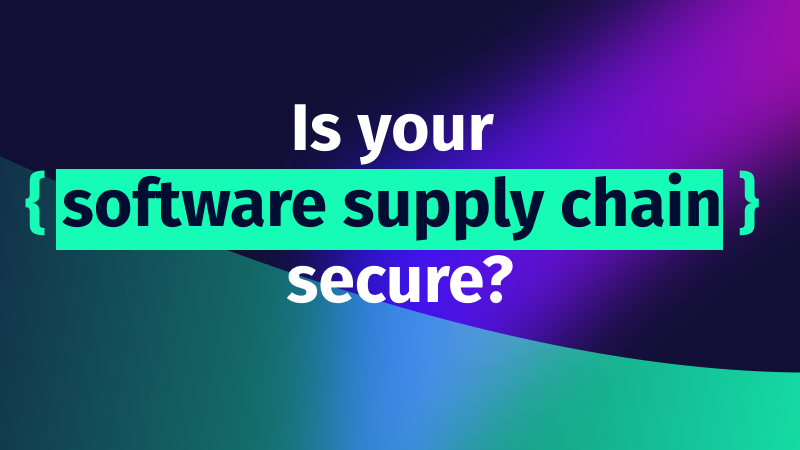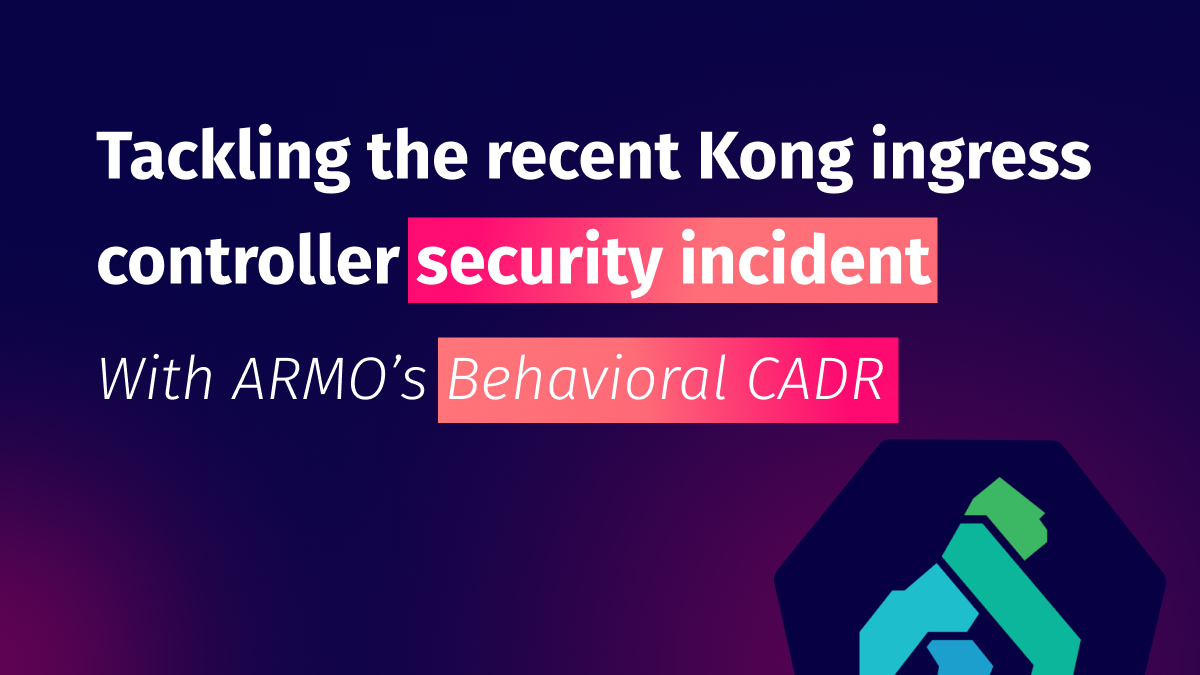ARMO Now Supports GKE Autopilot Clusters 🎉
We’re excited to announce that ARMO now fully supports Google Kubernetes Engine (GKE) Autopilot clusters!...

Sep 28, 2022
The tech sector is expanding aggressively. And for businesses and services, keeping up with this growth implies only one thing: integrate new technologies and innovate at pace or be left out.
The growth in the past in this sector has resulted in numerous open-source programming languages and frameworks that are easily obtainable by enterprises to benefit from and meet customer expectations. As simple as this may sound, launching stable and secure software or products to competitive markets is only what happens at the surface. On the surface, bringing continuous improvements, scalability, and security; testing features; configuring specifications, and manually integrating services over time introduces unique challenges to software development.
DevOps principles offer an ingenious solution to tackle these challenges. DevOps is a set of practices that emphasize the collaboration and communication of both software developers and other information technology (IT) professionals while automating the process of software delivery and infrastructure changes. It comes packed with a perfect blend of tool sets, practices, and cultural philosophies for development and operations with an added advantage of increased efficiency, delivery speed, and overall security.
CI/CD sits at the core of DevOps. The main aim of CI/CD is to automate and streamline the software development process by making small changes and additions incrementally. It helps in pushing out features faster with fewer errors. When implemented correctly, it generalizes the complete develop and deliver cycle with the you-build-it-you-own-it pipeline concept, and rapidly makes features market ready. It amplifies developer productivity and extensively helps fulfill organizational goals.
This post will cover everything about CI/CD and CI/CD security, as well as some common threats and best practices.
As mentioned earlier, CI/CD is an integral part of DevOps. DevOps teams use it to push out features and updates quickly, frequently, and with fewer errors. In simple words, CI/CD is a method of automating the software development process so that small changes can be made incrementally.
CI/CD (continuous integration/continuous delivery or deployment) is the foundation on which DevOps processes operate. CI/CD enhances the pace of continuously packaging client and business requirements to deliver an end product with a whiff of extensibility and performance boost. Although widely referred to as the same, DevOps and CI/CD are two completely different methodologies.
DevOps enables development teams to streamline and automate processes/workloads with proven approaches and is at the heart of the software development life cycle. CI/CD allows teams to constantly create new features and push features onto a central repository to deploy faster to meet deadlines.
CI/CD focuses on implementing workflows and automating everything. The general rule of thumb is that manual tasks with repeated iterations need to be automated. Bringing together production readiness and automation with the use of meaningful and secure integrations with third-party software and libraries in no time is where CI/CD shines. In CI/CD, automation is favored over manual processes to achieve speed, agility, and reliability.
Without CI/CD, the team silos tend to make the process tedious and slow. CI/CD effectively aims to break down silos between developers and operations to make the plan depicted above continuous and without friction.
The other integral part of CI/CD and DevOps is collaboration. To achieve successful collaboration, it is important to have a shared vision and agreed-upon objectives. Everyone should be aware of what needs to be accomplished and why it is essential. Furthermore, it is critical to break down silos and have a common understanding of the development process.
The CI/CD pipeline represents an agile set of streamlined tasks that are chained together to generate workflows, some cyclic and some acyclic.
The whole intent of a CI/CD pipeline is to facilitate the execution of end-to-end stages of application delivery in an efficient and errorless routine. These pipelines interlace and automate all phases of the software development life cycle so that all stages from development to deployment are seamlessly triggered through a single execution point.
A CI/CD pipeline can be as simple as developing an evolving workflow to move a file from a source to a destination with new integrations and security patches or as complex as building an entire software service iteratively.
When executed diligently, CI/CD delivers numerous benefits to the business and end users, making it one of the most sought-after practices in modern application delivery. The following are a few of the many benefits CI/CD pipelines offer.
The prime goal of CI/CD implementation is to quicken software development with iterative updates. It promises to deliver features to users at a much faster rate with lesser time spent on the development process.
With a managed and automated CI/CD pipeline, developing and deploying changes to production becomes a regular and non-eventful task that can be accomplished in a matter of hours or days. The development process is no longer stalled waiting for the next big release as features can be deployed to production as soon as they are ready.
Along the integration process, development teams combine and implement the best practices and standards of the modern and internal proven libraries into their tech stack, improvise as they go along, document and maintain better performing standards for upcoming projects and extend the performance and quality.
With automation being the centerpiece of CI/CD, developers can automate and reuse tests across different workflows and diverse scenarios. This benefit of CI/CD pipelines enables code reusability by handling repeated builds, tests, and environmental deployment tasks.
CI/CD enforces coordination across cross-functional teams by breaking operational silos. A team’s flexibility in collaborating efficiently enhances a feedback loop that offers performant and efficient alternatives to known solutions.
Periodic collaboration between multiple stakeholders also eliminates requirements bottlenecks and allows teams to develop independently by avoiding conflicts. Creativity and communication are further amplified by the ability to develop and test code rapidly without compromising quality.
Maintaining code in a central version control system opens the door to extending the code quality with tests and formatting. This ensures that on every pull request, the code gets validated against tests, pull requests undergo review by the admin, and changes are merged strictly upon pass status. The approach also helps identify code bugs before the merge and gives a better overview of what to refactor and where.
The reduced risk and review make CI/CD a promising approach to minimizing security and configurational flaws, enabling developers to launch a safe and reliable product to the market.
CI/CD is best at carrying out live incremental changes. Deploying code changes iteratively highlights the most common pain points and mistakes the development teams undergo. Developers can overcome these problems by introducing a managed and automated pipeline with proven best practices that help bring the feature to production efficiently.
In the event of production, the main benefit of CI/CD is that we can roll back to a previous working version of our product and fix the current patch separately. This benefit lessens the system downtime and increases compliance and confidence.
While automation and team-level collaboration are two of the most crucial benefits of adopting a CI/CD practice, administering security in such frameworks is often more complex than doing so on legacy models. CI/CD security is the ideology of bringing security into DevOps, securing the pipeline, and streamlining a workflow that meets compliance standards.
This is in line with the “shift-left” testing philosophy. In other words, it’s better to detect and prevent security issues as early in the development process as possible.
But why is this important? Most of the time, when an application reaches the production stage, it has already been through multiple rounds of development, testing, and refinement. By the time it gets to prod, the code is pretty stable. So if a security issue does arise at this stage, it’s usually because of a misconfiguration or an external threat.
With CI/CD security in place, on the other hand, any potential security vulnerabilities can be detected and corrected much earlier in the development process – before they have a chance to cause any damage. DevOps pipelines tend to introduce code repositories and container image registries that can be private or public. This can bring in misconfigurations or additional open-source vulnerabilities. CI/CD security is the best way to tackle these issues at the root.
Poisoned pipeline execution (PPE) is a type of software vulnerability that can be exploited by attackers to inject malicious code into a running process. The vulnerability can be exploited to take control of the process or to cause the process to crash. PPE vulnerabilities are often found in both client-side and server-side applications that accept untrusted input without appropriate data sanitation.
An effective approach to prevent PPE vulnerabilities is to avoid using untrusted input in server-side applications and to avoid using untrusted output (generated from the server) in client-side applications. As a recommended practice, all untrusted input should be carefully validated to ensure that it does not contain any malicious code. As for untrusted outputs, the data should be displayed as untrusted and should be used with caution.
Although poisoned pipeline execution vulnerabilities can be difficult to exploit, they pose severe consequences if exploited successfully.
When distributed teams develop or make changes to one part of the module, unified access unintentionally changes the state of other dependent sections. In such instances, setting unified access to pipelines is not recommended and can become daunting very quickly as CI/CD is all about collaboration from diverse teams.
Insufficient access controls can be detrimental to security as they can lead to privilege escalation and data leakage. An attacker with low privileges may be able to gain high-privileged access or modify code that is not supposed to be accessible. Also, if there are no access controls in place, an attacker may be able to view or tamper with data that is not intended for them.
A common CI/CD security threat arises through the ungoverned use of third-party services. Although this offers developers the freedom to choose the services they intend to use, this can introduce a number of security issues, as the security risks associated with using these services are either unknown or ignored.
For example, a developer may choose to use a public code repository and container image registry that is not owned or controlled by their company. This code repository may not have the same security controls in place as the company’s internal code repositories. As a result, the code that is stored in this public repository may be less secure and more vulnerable to attack.
To help mitigate these risks, companies should adopt policies and procedures governing the use of third-party services. Enforcing such policies should ensure that only approved services that satisfy the organization’s security controls are used and are updated regularly to tackle the changing threat landscape.
Another common CI/CD security issue arises from the abuse of dependency chains, which represent a series of dependencies between components of an application stack.
For example, a web application may depend on a number of other components, such as a database, an application server, and a web server. Attackers may exploit a vulnerability in the database that allows them to execute arbitrary code on the database server. They can then use this code execution to gain access to the web application and the application server. This type of attack is known as a “dependency chain attack“.
To help mitigate dependency-based risks, organizations should carefully consider and manifest dependencies between components in their systems. They should also put in place policies and procedures to ensure that these dependencies are maintained and monitored to prevent vulnerabilities.
Security gates can be embedded deeply in both CI and CD pipelines. Their purpose is to detect security issues early and prevent them before they reach production, such as documented vulnerabilities, common misconfigurations, permissions, and others. CI/CD security gates include not only the technical controls that need to be applied but also the way we think about security posture, risk appetite, and how to continuously enforce cloud-native security in an ongoing manner.
Ad-hoc development and testing with hardcoded values is attractive and gets the job done on the go, but placing keys and tokens in the code can trigger a security compliance issue. Avoiding this at all costs is ideal.
The recommended practice is to use environment variables, which are variables that are set outside of the code and can be used by the code at runtime. This way, secrets are not hardcoded in the code and can be easily changed without having to modify the code itself.
Configurations sometimes get executed irrespective of the source and permissions, producing unclear error stack traces and making debugging a nightmare.
The recommended approach is to place config variables within different files using use-case-specific naming conventions to avoid conflicts and crashes in both non-prod and prod environments.
As global and implicit values in the code complicate refactoring and debugging, a recommended practice is to use explicit, private, and immutable variables. The practice increases the stateful and stateless guarantees with an added advantage in developing performant and secure code.
As most CI/CD pipelines are deployed and reside in the cloud, interacting with external services and platforms is typically achieved via REST API. Allowing infrastructure resources to open public connections and access to all user groups can however lead to data exposure and GDPR compliance.
To prevent this, it is recommended to restrict security policies and resource access to limited groups for enhanced security and trust.
It is crucial to keep a tab on what went wrong and which part of the workflow is susceptible to attack vectors. Setting up logging at different levels and declaring paths for log collection during the initial stages of development helps keep a track of the execution of pipeline stages.
CI/CD security comprises multiple comprehensive and multi-layered approaches to toughen pipeline security at every stage. The layers are listed as follows:
Bugs and misconfigurations are easy to bypass into production. The runtime security layer plays a vital role in scanning and detecting security leaks and threats from live applications running in production through a monitoring standpoint.
Before the deployment stage, the code developed by internal teams has to undergo pre-defined tests for identifying potential vulnerabilities. The static security testing layer is about creating test cases in version control systems for detecting vulnerabilities before merging the features into the main branch.
Extend test cases of automated pipelines by adding application and environment scans to detect and classify weak code, infrastructural gaps, and third-party service resource leaking.
A comprehensive vulnerability scanning also helps maintain a central repository with known vulnerabilities. Scanning the pipeline helps detect and compare classified issues with the scanned changes in the merged repo for remediating vulnerabilities.
One of the most important things you can do is keep your systems up-to-date and free from any vulnerabilities. This process is known as misconfiguration scanning, and it involves regularly scanning your system for any potential security issues.
One of the most common ways that hackers gain access to systems is through vulnerabilities that exist due to poor configuration. By regularly scanning your system, you can ensure that any potential issues are found and fixed before they can be exploited by criminals.
In addition to keeping your system secure, misconfiguration scanning can also help improve its performance. By ensuring that all of your system’s components are properly configured, you can help eliminate any bottlenecks or other issues that can slow down your system.
Logging phases of pipeline execution and tracking the success and failure patterns can be a resource in analyzing defect patterns and vulnerability detection for the overall CI/CD pipeline’s security enhancement.
Periodic auditing can help tackle evolving threats because it gives an overview of the system’s health and resource utilization. The security team can use this data to further fine-tune detection mechanisms and response processes.
Continuous integration and delivery pipelines have become integral to DevOps processes. A paradigm shift is underway that emphasizes automating the entire process of code development, testing, and deployment while ensuring compliance with security best practices.
As more and more businesses move towards a fully automated CI/CD culture, the challenge for enterprises will be to evolve their security practices to meet the needs of a fast-paced, continuous delivery model.
In this post, we discussed the importance of CI/CD security for DevOps processes and looked at the different layers of security that need to be considered for a robust pipeline. We also looked at some possible ways to secure and protect your pipeline from potential attacks.

The only runtime-driven, open-source first, cloud security platform:
Continuously minimizes cloud attack surface
Secures your registries, clusters and images
Protects your on-prem and cloud workloads

We’re excited to announce that ARMO now fully supports Google Kubernetes Engine (GKE) Autopilot clusters!...

Software supply chain attacks cost businesses $45.8 billion globally in 2023 alone, and is projected...

Imagine this situation: you recently updated one of your infrastructure software components. A few weeks...